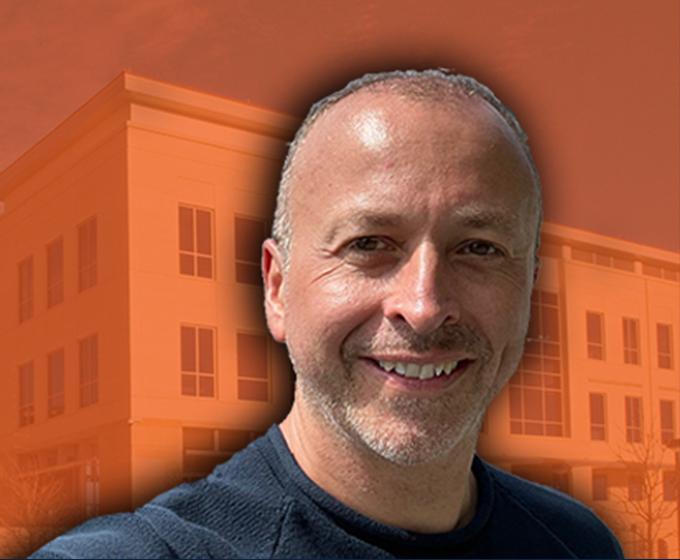
DECEMBER 22, 2021 — Editor’s note: This op-ed by Chris Packham, professor of astrophysics in the UTSA Department of Physics and Astronomy, originally appeared in the San Antonio Express-News.
This week, the world’s largest space telescope is scheduled to leave the launch pad in French Guiana to travel to its destination 1 million miles from Earth. From this location, the behemoth will provide astronomers with exquisite images of the cosmos just after the Big Bang. It will also probe exoplanet atmospheres and peer into the maelstrom surrounding super massive black holes in distant galaxies.
The James Webb Space Telescope, or JWST, achieves this through a mirror that collects seven times more light than the Hubble Space Telescope, operating deep into the infrared spectrum.
Anticipation is astronomical — pun intended — as astronomers have been waiting for this moment for more than 20 years. The $10 billion telescope is perhaps the most advanced space instrument in existence. Hundreds of components have to perfectly operate in synchronicity.
It took the combined efforts of NASA and European and Canadian space agencies to make this possible. Astronomers around the world have been using Hubble and ground-based telescopes to prepare for this momentous occasion.
The group that I co-lead at the University of Texas at San Antonio includes around 55 astronomers from Japan to Alaska and many places in between. Earlier this year, we were awarded 53 hours on the JWST to peer into the centers of galaxies and super massive black holes.
We know that black holes can be overwhelmed if they attract too much material. When material falls into a black hole, it creates pressure due to the immense amount of released energy, and it can blow gas and dust back toward the galaxy. The precise nature of how this happens and the impact to the galaxy, however, remain poorly understood. This process could have a significant effect on the evolution of galaxies, so incredibly to fully understand the solar system, and hence our own place in the universe, it might be necessary to analyze black holes.
Using UTSA’s upgraded high performance computing, our research team will curate the JWST’s data and perform the initial data analysis. We’ll publish our results and present at international conferences with what are sure to be key knowledge advances.
UTSA students will participate in this once-in-a-lifetime endeavor. This is especially important at UTSA, a Hispanic Serving Institution that is working to increase the representation of minorities and people of color in science. While we expect many answers from the data gathered by the JWST, we also expect new questions to arise. This research cycle will create learning opportunities for students and early career scientists.
Experiential learning is critical to professional preparation, so to support this process, we are launching two new courses at UTSA. Leadership in Science Integration Program will help students learn to lead high-tech instrument groups for astronomy and other forums where imaging is needed (i.e., military, automotive, medical). Philosophy of Space Exploration will enable students to explore grand questions such as the definition of life, human-based rights and the ethics of space tourism. These courses will use online teaching approaches and integrate Adobe Creative Campus and gamification to engender digital fluency.
At the same time, our work stimulates connections to high school education through the San Antonio Teacher Training Astronomy Academy, our teacher training program, and events jointly held at the Witte Museum. This will further strengthen a San Antonio STEM pipeline that includes astronomy.
In our teaching and research, we harness the inspirational nature of astronomy to nurture curiosity, critical thinking and a love of the universe. The James Webb Space Telescope will help us create the diverse and inclusive university and astronomical communities we need to unlock the mysteries of space.
UTSA Today is produced by University Communications and Marketing, the official news source of The University of Texas at San Antonio. Send your feedback to news@utsa.edu. Keep up-to-date on UTSA news by visiting UTSA Today. Connect with UTSA online at Facebook, Twitter, Youtube and Instagram.
Move In To COLFA is strongly recommended for new students in COLFA. It gives you the chance to learn about the Student Success Center, campus resources and meet new friends!
Academic Classroom: Lecture Hall (MH 2.01.10,) McKinney Humanities BldgWe invite you to join us for Birds Up! Downtown, an exciting welcome back event designed to connect students with the different departments at the Downtown Campus. Students will have the opportunity to learn about some of the departments on campus, gain access to different resources, and collect some giveaways!
Bill Miller PlazaJoin us for an intimate evening of cocktails, conversation, and culinary inspiration with Pati Jinich, Emmy-nominated chef and James Beard Award-winning author. Enjoy light bites and signature drinks in the warm, modern setting of Mezquite as Pati connects with guests over her passion for Mexican cuisine and storytelling.
Mezquite Restaurant in Pullman Market, 221 Newell Ave., San Antonio 78215From inspired courses to thoughtful pairings and a rich sense of community, the Ven a Comer Signature Dinner is a night of shared meals, shared stories, and unforgettable flavor.
Stable Hall (Pear Brewery), 307 Pearl Pkwy, San Antonio 78215Come and celebrate this year's homecoming at the Downtown Campus with food, games, giveaways, music, and more. We look forward to seeing your Roadrunner Spirit!
Bill Miller PlazaThe University of Texas at San Antonio is dedicated to the advancement of knowledge through research and discovery, teaching and learning, community engagement and public service. As an institution of access and excellence, UTSA embraces multicultural traditions and serves as a center for intellectual and creative resources as well as a catalyst for socioeconomic development and the commercialization of intellectual property - for Texas, the nation and the world.
To be a premier public research university, providing access to educational excellence and preparing citizen leaders for the global environment.
We encourage an environment of dialogue and discovery, where integrity, excellence, respect, collaboration and innovation are fostered.